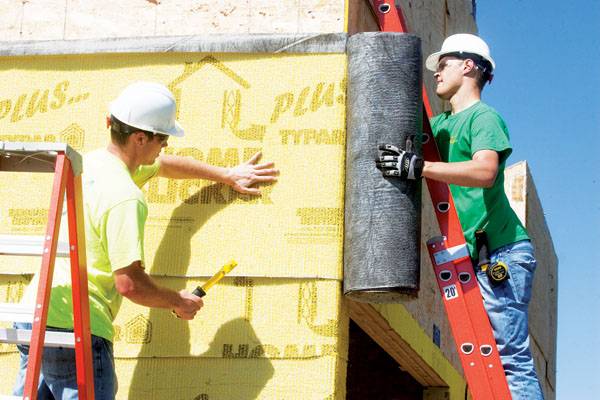Here Comes the Sun

Chase Rickard,left and Aaron Anderson, right, work on installing a waterproof barrier around the Solar Decathlon house on Tuesday.
May 20, 2009
The ISU Solar Decathlon team has moved construction of its solar-powered home outdoors and is facing few problems as the team prepares for competition in October.
The Solar Decathlon is an international design competition in which 20 college teams compete to build the most energy-efficient solar-powered homes; it is sponsored by the U.S. Department of Energy. Teams transport their homes to Washington D.C. in October, where they are judged in 10 areas, according to the department’s Web site.
“Based on what we know of the other teams’ statuses, we’re in pretty good shape right now,” said Clare Cardinal-Pett, associate professor of architecture and faculty adviser to the team. “During some months, we were the only team that accomplished what we had to do.”
Some of the most prestigious design and architecture universities across the globe participate in this competition, including Cornell University, Santa Clara University and the University of Technology in Darmstadt, Germany, which won the competition in 2007.
The ISU team’s advantage may be in its design.
“Some teams focus on the flash factor, and they forget about the fact that these houses will be around and lived in,” said Aaron Brncich, graduate student in construction engineering and project manager for the team. “Traditional ideas aren’t always bad, but the problem happens when people get lazy and don’t fix the faults when they first occur.”
Currently, the construction of the house is right on schedule.
“Our biggest problem right now is more logistical: trying to nail down an affordable solution for transporting the house parts to the competition site in Washington, D.C.,” said Eric Berkson, senior in architecture and IT director for the team. “This really speaks to the strength of the design.”
Mikesch Muecke, associate professor in architecture and another adviser to the group, said while the project did have some innovative dimensions, it was not intended to be revolutionary.
“That’s not part of the idea,” he said. “We’re really using stuff off the shelf. It’s our way of saying, ‘anyone can do this.’”
Brncich, the man in charge of actually assembling the house, agreed.
“The biggest problem I’ve had to deal with so far is all the rain we’ve gotten recently, but that happens to everyone,” he said.
The core idea of the house design is to make it modular, with the house consisting of six similar parts to be assembled on site at the competition. Called the Interlock house by the team, it is a model of sustainability because, after moving past some admittedly high startup costs, it costs very little to maintain.
“I would estimate that people who would want to build this would pay $300,000 for the parts,” Brncich said. “But after that, there’s virtually no upkeep costs. In terms of electricity, the house is actually net negative, so you could conceivably sell power back to the power plant.”
The next step in construction of the house is setting up the electrical wiring. The house has to be shipped out to Washington D.C. by the first of October and will be constructed on the National Mall, thoroughly inspected and judged for points.
The house is not intended to just be a concept for a possible house, but be a house that can realistically be used.
“One of the competition rules is that we have to serve dinner in the house to the other teams,” Cardinal-Pett said.
Although none of the houses created in previous competitions have actually been mass produced, some teams reuse their homes on campus.
“Some places use one or two for their own uses,” Berkson said. “For example, our new design dean, Rico-Gutierrez; his old office at Carnegie Mellon was a former Solar Decathlon house.”
Solar Decathlon teams are judged on:
Architecture — 100 points
Market viability — 100 points
Engineering — 100 points
Lighting design — 75 points
Communications — 75 points
Comfort zone — 100 points
Hot water — 100 points
Appliances — 100 points
Home entertainment — 100 points
Net metering — 150 points
— Source: U.S. Department of Energy
Web site
















